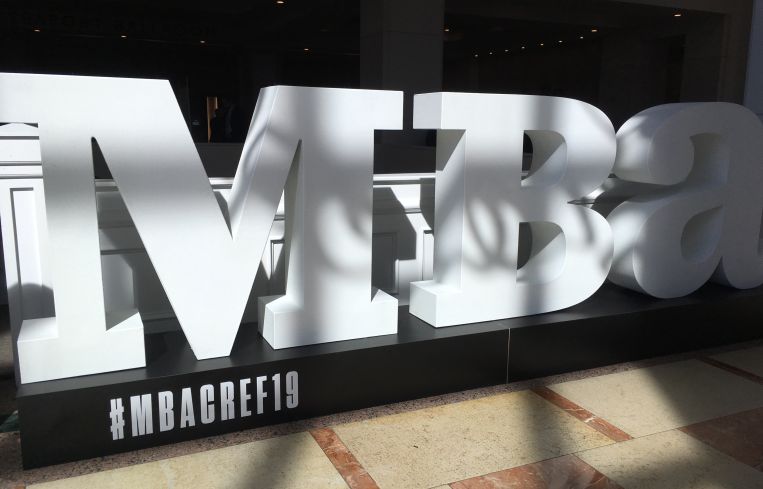In Transition: Bridge Lenders Talk Competition, CLOs and Opportunity Zones
By Cathy Cunningham February 14, 2019 5:43 pm
reprints
If you’re a bridge lender in today’s crowded debt markets, you’d best be on your A-game. Three of the industry’s best gave MBA CREF19 conference attendees an overview of the current transitional lending environment and how they’re staying ahead of the competition.
There was plenty to talk about. A tidal wave of capital has flowed into the bridge lending sector—partly spurred by an increased amount of dry powder in the private equity space and capital moving out of core and into value-add opportunities—and it doesn’t seem to be retreating any time soon.
Despite being forced to duke it out for most deals, panelists were refreshingly complimentary when quizzed about the seemingly never-ending stream of competitors in the ring, with Matt Salem, the head of real estate credit at KKR, describing his challengers as “extremely sophisticated.”
KKR’s loans range from $50 million to $500 million, but the competition starts to thin out around the $100 million to $150 million spot, Salem said. And while competing on spreads—which have compressed around 100 basis points (bps) over the past 12 months from LIBOR +375 bps to LIBOR +275 bps—is de rigueur, there’s no toying with structure or proceeds, unlike the pre-crisis days. “Our borrower base won’t take additional proceeds,” Salem said. “It’s a pretty healthy market from both a credit and structure perspective.”
As the bridge sector continues to evolve, as does what constitutes its collateral, with Salem pointing to KKR’s $214 million loan to Related Beal for its $276 million acquisition of 451 D Street in Boston’s Seaport District as a perhaps “less likely” bridge loan. The asset was 80 percent occupied at the time and KKR’s three-year loan (with two one-year extension options) carried a coupon of LIBOR plus 2.4 percent.
But, perhaps unsurprisingly—given the advanced age of the cycle (which at this point will die of old age before anything else, some attendees said) and transitional lending’s inherent risk—sponsorship remains key.
ACRES Capital is focused on heavy value-add bridge lending— with an average loan-to-value of 65 percent—and utilizes a hands-on approach with sponsors and managers. “We’re extremely sponsor-driven,” said Marty Reasoner, a managing partner at ACRES said. “We look at the manager, their experience and whether or not the business plan works.”
Exit strategies aren’t far behind, with ACRES factoring in downside scenarios and placing “heavy” importance on asset management, Reasoner said. The lender recently opened a Chicago office and is finding opportunities in the Midwest, which isn’t so institutionally banked.
John Lippman, a senior director at New York Life Real Estate Investors (NYL) said that his firm looks at transitional lending opportunities wearing a construction lender’s hat when determining whether the deal represents appropriate risk-adjusted returns or not. The lender did $7.2 billion in originations last year, the majority of which were fixed-rate, but has “re-formalized our involvement in bridge lending,” Lippman said.
Increased bridge lending activity has been fueled by the white-hot CRE collateralized loan obligation market, which acts as a financing vehicle for transitional lenders. A potentially worrying pattern is that loans are increasingly originated to fit the requirements of rating agencies’ profiles in terms of size and cash flow, panelists said.
When opportunity zones—the buzz word of the year thus far—popped up panelists agreed that, well, there are no direct opportunities yet. While panelists expressed some hope that the incentive will help with take-out financing for assets that are already in designated opportunity zones, the general consensus is that if the deal doesn’t make sense minus the incentive it’s simply a losing asset which happens to be in an opportunity zone. Fundamentals have to be firmly in place to make a deal work, and it’s preferable to be lending in a market that is already growing.
When the conversation swung around to asset types, panelists were in agreement that retail remains a tricky bet for transitional lenders.
KKR’s lending portfolio comprises roughly 80 percent office and multifamily assets, with retail properties accounting for only “low single digits,” Salem said. The precarious element to bridge retail lending is the sector’s uncertainty coupled with its transitional state, meaning that lenders have to bet on the tenants as well as the real estate. “You need a crystal ball to see what will happen over time,” Salem said.
ACRES isn’t shying away from retail but gravitates towards quality infill locations, and assets that can be repositioned into a different use. “We’re not afraid of it,” Reasoner said. NYL is also primarily focused on adaptive re-use opportunities.
Industrial opportunities are few and far between, of course, and therefore the most coveted. “There’s investor demand but no product,” Lippman said.


